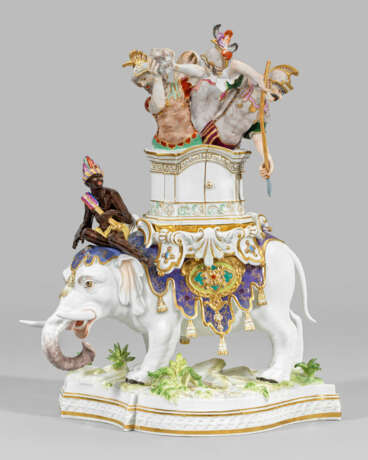ID 942764
Lot 2145 | Meissen "Kriegselefant II". Originaltitel
Estimate value
€ 18 000 – 36 000
Profilierter, frontseitig passig geschweifter Sockel mit reliefierter Flechtbandbordüre. Über steinigem Terrain mit plastischem Blattwerk stehender Elefant mit aufgerissenen Augen, geführt von einem Mohren mit gelbem Lendenschurz und federbekrönter Kopfbedeckung, in der Hand zwei Pfeile haltend. Auf dem Rücken des Tieres eine prächtige, mit Goldranken und Edelschmuck verzierte, lavendelblaue Schabracke mit Quasten, darüber ein architektonisch aufsteigender "Turm", umzogen von reliefplastischen Palmetten, Rocaillen und Lambrequins, mit drei stehenden, den Feind abwehrenden, brustgepanzerten Soldaten, bewaffnet mit Wurfspeer, Stein, Schwert und Schild. Polychrome Malerei mit reicher Goldstaffage. Entw. Johann Joachim Kaendler, 1773. Modell-Nr. 16. Rest.; Schwertermarke. Meissen. Um 1900. H. 41 cm. 28 cm x 16 cm.
Imposante Ausformung einer von Johann Joachim Kaendler 1773 entworfenen Figurengruppe aus der sog. "Großen russischen Bestellung" für die Zarin Katharina II. von Russland, genannt Katharina die Große. Der Auftrag beinhaltete verschiedene allegorische und mythologische Porzellanfiguren und -gruppen, die Kaendler teilweise in Zusammenarbeit mit seinem Mitarbeiter Michel Victor Acier ausführte und mit denen die Kaiserin das Kabinett im Pavillon an den Rodelbergen im Park Schloss Oranienbaum ausstatten ließ. Diese gilt als die umfangreichste unter den Bestellungen für den Zarenhof. Wie auch das Pendant "Kriegselefant I" symbolisiert diese Gruppe den russisch-türkischen Krieg von 1768 bis 1774. Kriegselefanten, zumeist männliche, indische Wildelefanten, wurden zu militärischen Zwecken eingesetzt und waren u.a. mit Bogenschützen und Speerwerfern bemannt, die in einem auf dem Rücken des Tieres befestigten "Turm" aus Leder oder Holz untergebracht waren. Sie spielen zudem auf die im zweiten Punischen Krieg eingesetzten Elefanten des Feldherrn Hannibals von Karthago und seinen Sieg im Gefecht von Ticinus um 218 v. Chr. an.
Vgl. Pietsch, Kat. Meissen für die Zaren, S. 103, 116f.
An imposing porcelain group "War elefant II" modelled by J.J. Kaendler in 1773, part of the "Great Russian order" of Catherine the Great. Restored. Crossed swords mark.
Meissen. Um 1900.
| Manufactur: | Meissen Porcelain Factory |
|---|---|
| Auction house category: | Porcelain |
| Manufactur: | Meissen Porcelain Factory |
|---|---|
| Auction house category: | Porcelain |
| Address of auction |
Kunstauktionshaus Schloss Ahlden GmbH Große Str. 1 29691 Ahlden(Aller) Germany | ||||||||||||||
|---|---|---|---|---|---|---|---|---|---|---|---|---|---|---|---|
| Preview |
| ||||||||||||||
| Phone | +49 5164 80100 | ||||||||||||||
| Buyer Premium | 25.0 | ||||||||||||||
| Conditions of purchase | Conditions of purchase | ||||||||||||||
| Business hours | Business hours
|



